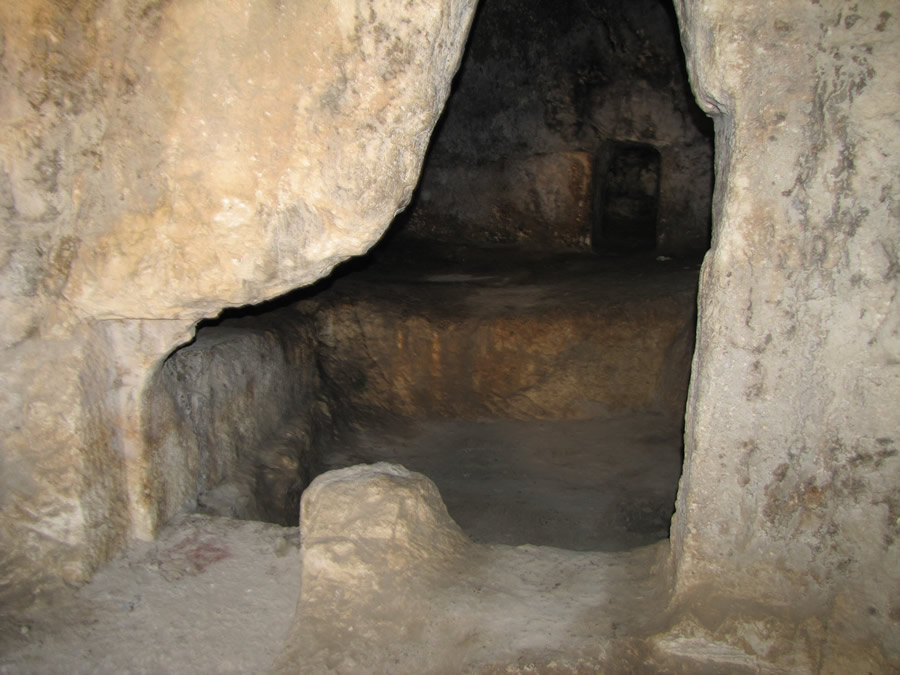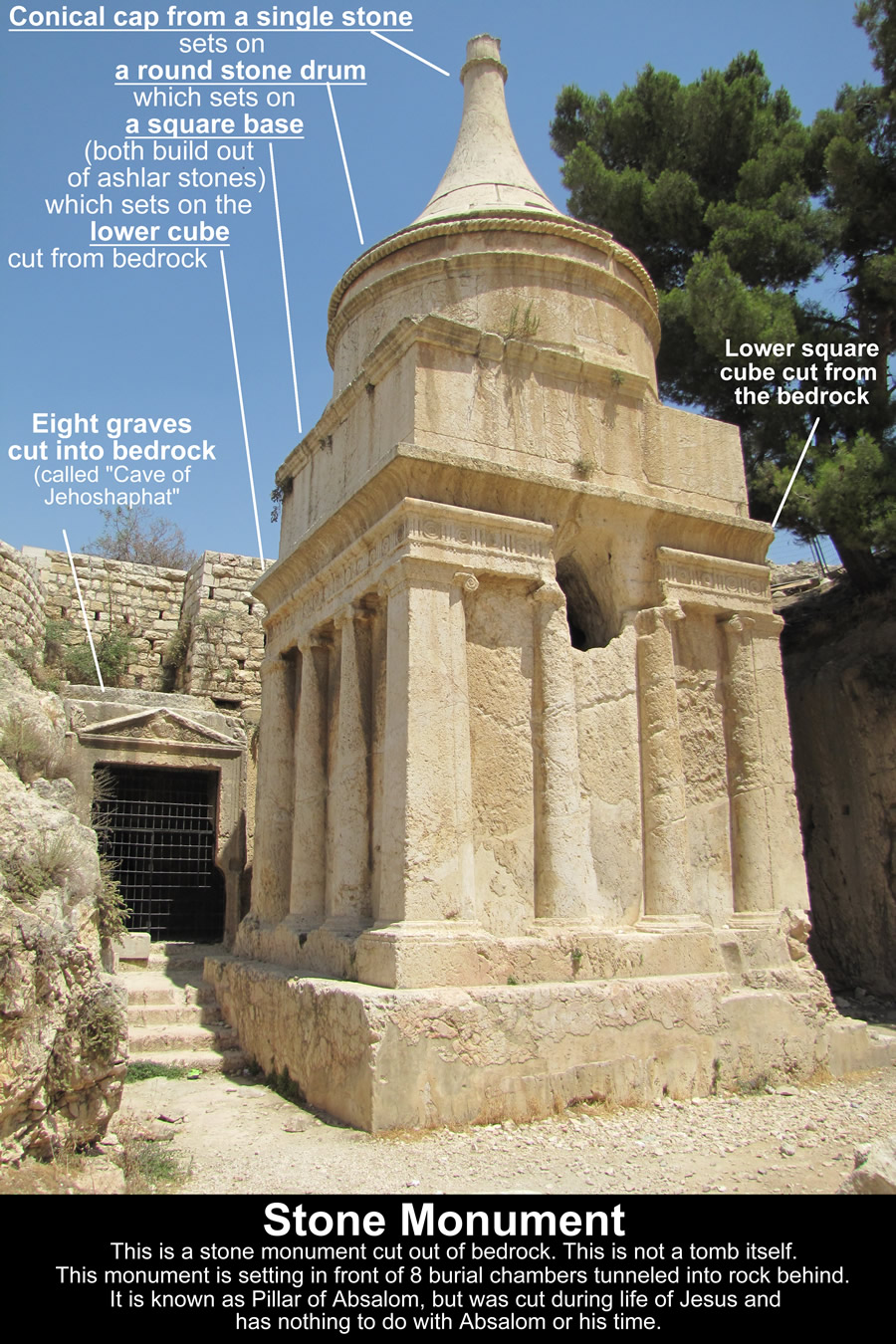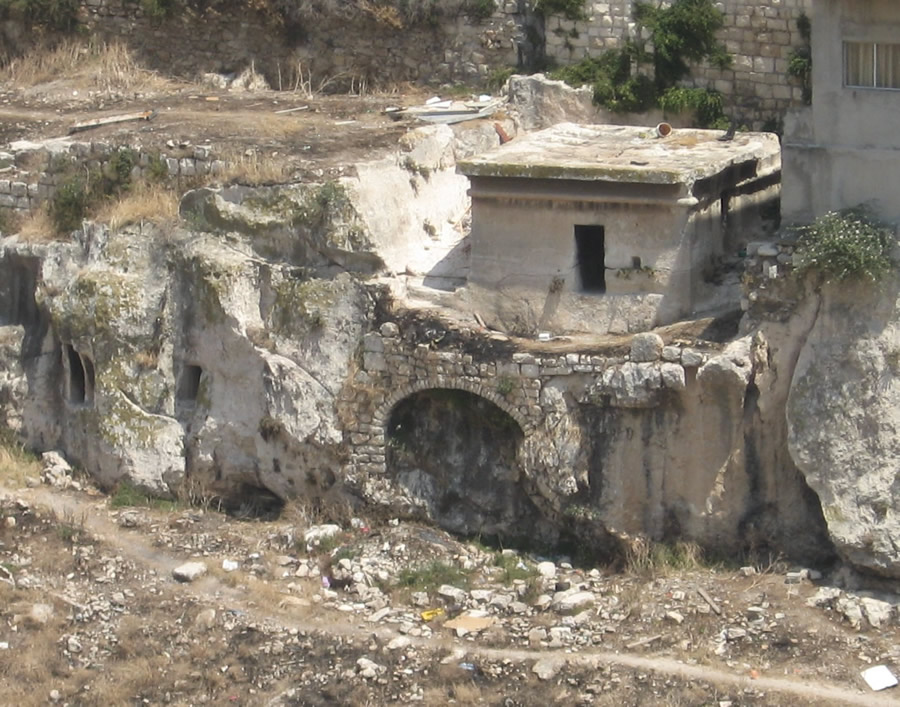Since the Jews would not bury their dead inside the city walls, Jerusalem is surrounded by tombs. There are tombs to the west in the Hinnom Valley,
|
|||||
(CLICK ON IMAGES FOR A LARGER IMAGE) |
|||||
Here is a close up of the tomb belonging to a family of priests named Bene Hezir (or, sons of Hezir). 1 Chronicles 24:1 and 15 mention a priest named |
|||||
 |
|||||
 |
|||||
 |
|||||
| The entrance into the Bene Hezir Tomb found behind the decorative pillars that are seen in front of the Bene Hezir Tomb from the Kidron Valley and Jerusalem. | |||||
 |
|||||
| The burial bench around the inside of the Bene Hezir tomb in the Kidron Valley with three shafts called Kokhim, or loculi, to place the wrapped body of the deceased. | |||||
 |
|||||
| Burial bench where the deceased was placed to be wrapped with spices before being placed in the kokhim in the Bene Hezir Tomb in the Kidron Valley. | |||||
 |
|||||
| A kokhim shaft where the deceased was placed in the Bene Hezir Tomb in the Kidron Valley. Kokhim, or loculi, are long, narrow recesses cut into rock tombs that served as burial niches for the deceased. |
|||||
 This tomb, known as Zechariah's Tomb, was cut during the life of Jesus. Below is the same tomb as seen when standing in the Kidron Valley. Zechariah's Tomb is a cube cut out of the rock with Ionic pilasters and a pyramid top. "A" in the photo marks a corridor with steps that provides access to the tomb of the Bene Hezir family to the left. "B" marks a small chamber cut under the base to serve as a tomb. “C” is placed on one of the three rock walls that remained when the stone was cut away to shape this tomb or monument out of the bedrock of Mount of Olives. To the right (south) the letter “D” marks a tomb that was never finished. We may assume the Roman Wars beginning in 66 AD and the destruction of Jerusalem in 70 AD interrupted this unfinished tomb’s building process. This monument (called “Zechariah’s Tomb”) in the middle with the pyramid top may have been built to honor those who would be buried in the unfinished tomb to the south. |
|||||
 |
Zechariah's Tomb is a cube cut out of the rock with Ionic pilasters and a |
||||
|
|||||
(CLICK ON IMAGES FOR A LARGER IMAGE) |
|||||
 |
|||||
| This is a view looking between the rock wall and the side of Zechariah’s Tomb. The remaining rock wall is to the left (north) and the tomb/monument is to the right (south). The back corner and back wall (which is the bedrock of the Mount of Olives) can also be seen. | |||||
 |
|||||
(CLICK ON IMAGES FOR A LARGER IMAGE) |
|||||
 |
|||||
The three tombs as viewed from the Kidron Valley (from left to right): Ben Hezir, Zechariah and an unfinished tomb. |
|||||
 |
|||||
| Unfinished Tomb south of Zechariah's Tomb in Kidron Valley | |||||
(CLICK ON IMAGES FOR A LARGER IMAGE) |
|||||
 |
|||||
| Photos and map of tombs around Jerusalem | |||||
This tomb is just a little further north of the three previously mentioned tombs in the Kidron Valley. It was constructed during Jesus’ lifetime. Today it is traditionally called the Pillar of Absalom or Absalom’s Monument. The Bordeaux Pilgrim referred to it as the Tomb of Hezekiah in 333 AD. It was first associated with Absalom by Benjamin of Tudela in 1170 because of 2 Samuel 18:18. The actual person or family for whom this tomb was prepared is unknown. The architectural style includes both Egyptian and Greek influences, which would have come from the two kingdoms that dominated Judea between 300-100 BC. The Egyptian influence came from the Ptolemys of Egypt, and the Hellenistic style from the Seleucids, who were Greeks ruling in Syria. The lower square is cut from the bedrock. It is topped with a finely-cut circular stone with a conical top that was cut from one single stone. Directly to the left of this tomb is an eight-chambered catacomb with well-preserved carved stone. The catacomb is called the Cave of Jehoshaphat. The Pillar of Absalom may have been a monument for the burial chambers in the Cave of Jehoshaphat, cut into the cliff behind it. There are two inscriptions in this monument. A two-line inscription above the door is from around 400 AD that says: “This is the tomb of Zachary, martyr, most holy priest, father of John the Baptist.” A later inscription can be seen to the right of the door but only the word “simon’ can be made out. Neither inscription is historically valuable or accurate. |
|||||
 |
|||||
| Galyn climbs the base of the NT tomb known as the Pillar of Absalom in the Kidron Valley on the side of the Mount of Olives | |||||
 |
|||||
| A view from above the Tomb of Absalom looking south with the Pharoah's Daughter's Tomb in the background in the Kidron Valley | |||||
| Stone carving of the Tomb of Absalom from the rock on the side of the Mount of Olives | |||||
(CLICK ON IMAGES FOR A LARGER IMAGE) |
|||||
|
|||||
 |
|||||
| Pharaoh's Daughter's Tomb | |||||
 |
|||||
| Pharaoh's Daughter's Tomb | |||||
 |
|||||
| Pharaoh's Daughter's Tomb plus 5 more burial caves from 950-586 BC | |||||
 |
|||||
| Silwan Tombs 950-586 BC | |||||
(CLICK ON IMAGES FOR A LARGER IMAGE) |
|||||
 |
|||||
| Silwan Tombs fro 950-586 BC | |||||
| Detail map showing the location of the tombs located around Jerusalem: | |||||
 |
|||||
 |
|||||
| Ossuary - stone boxes kept in tombs to hold bones after flesh has decayed | |||||
 |
|||||
| Decorated Ossuary - stone boxes kept in tombs to hold bones after flesh has decayed | |||||
 |
|||||
| Decorated Ossuary - stone boxes kept in tombs to hold bones after flesh has decayed | |||||
(CLICK ON IMAGES FOR A LARGER IMAGE) |
|||||
These tombs (above and below photos) are on the east side of the Kidron Valley south of the Temple Mount and across from the |
|||||
 |
 |
||||
| Galyn's video of the Kidron Graves. | |||||
| Watch Galyn's video as he walks in the Kidron Valley past the tombs. | |||||
|
|||||
 |
UPDATED! 2022 - Open this link |
JERUSALEM: HISTORY, ARCHAEOLOGY AND Download a FREE online .pdf of "Jerusalem" HERE (click on the book cover to download the book as a .pdf ) |
|
|
|
|
|